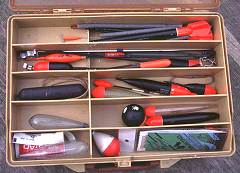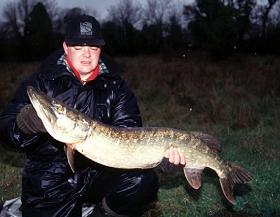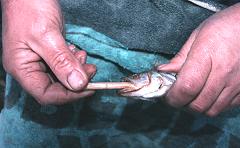There’s no denying it, there’s nothing quite like the thrill of watching afloat shudder and keel over as a pike picks your bait up. As it slides away,you pick the rod up wondering whether it’s going to be two pounds or twenty.
Laying on is a simple method to master. It’s virtually foolproof and if youset it up right, it provides you with instant indication of a run. All youneed to do is fish a sliding float, set slightly over-depth and fix a weighteither on the trace or just above it to anchor the bait on the bottom andcock the float. 
Let’s start with stillwaters. The best types of float to use are the slimbalsa pencils, attached to the line waggler style via a ring at the bottom.Most decent tackle shops stock them, or you can make your own at a fractionof the cost.
The float is stopped with a stop-knot or rubber rig stop around a foot ortwo over-depth. The weight varies from a couple of swan shot for calmer daysor shallower water, to four or five swan or a small or medium egg sinker tocope with a wind or deeper swim.
It’s worth plumbing the depth and getting to know the bottom contours ofyour swim. Gravel bars, marginal shelves and the sides of drop-offs are allpotential pike holding features.
When you cast the bait in the float should lie flat on the surface on aslack line. Place the rod in the rests, carefully tighten the line and itwill sit up. As soon as a fish picks the bait up, it’ll either move theweight and make the float keel over in the time-honoured lift bite, or slideunder as the pike moves off to swallow the bait. Wind down to the fish andstrike quickly either way to avoid a deep-hooked pike.
Hardly rocket science, is it…? And once you get the hang of it, there are ahost of little dodges you can use to sharpen up on presentation. I preferswan shots because it’s easy to add or subtract weights without breaking therig down. I pinch them on the trace wire, rather than the line, usually 18inches or so away from the bait.
If you make your own traces, slide an inch or so of fine silicone tube ontothe wire to pinch the shots onto. That way you can move the weights if youneed to without damaging the wire. 
On calmer days, you can get away with two or three swan shot, which willjust be enough to anchor the float so it sits up on a tight line. If it’swindy, you may need to add more weight to anchor it down, so you can sinkthe line without the line dragging the float back towards you.
I prefer floating braids to mono for piking. Notwithstanding their lowdiameter and lack of stretch, I like to know my line’s on the top, out ofthe way of any potential snags.
Obviously if it floats, the wind is going to blow a bow into the line. Ifthis tows the rig out of position, try adding more weight. If it pulls thefloat under, slip a bigger float on. Making your own means you can knocktogether a range of balsa pencils in different lengths and diameters foraround 25p a float in a couple of evenings.
Attaching floats to the line via a snap link swivel means you can changethem instantly should conditions require. 
Twitching the bait a foot or two every few minutes will often provoke atake. You can also pop the bait up by adding buoyancy in the form of a balsastick stuffed down its throat or a bait popper (or a sliver bit of cork…)wired to the bottom treble on the trace. Varying the distance between theweight and the bait varies the distance the bait sits off the bottom – itpays to experiment.
Laying on works a treat on slow moving rivers and drains too. In flowingwater, it’s best to sit slightly downstream of your chosen swim and castupstream to it. As you tighten up, the flow should help drive the floatagainst the stop knot, making it sit upright.
You may find you have to fish slightly more over depth to stop the floatbeing dragged under, or use a bigger float to ensure it stays on the topwhere you can see it. In stronger flows, which drive a pencil float under,switch to a more buoyant through-the-middle slider, like one of the DrennanPiker or Zeppler designs, or even the good old fashioned polyball.
Laying on is a great method if you’re new to piking. As long as the float’sset properly and the line’s tight, it will register a take as soon as a pikepicks your bait up.
One thing to avoid are the loaded float designs, which sit up regardless ofwhether the line’s properly tightened or not. In the wrong hands these arepotential killers, because a fish can pick the bait up off the bottomwithout the take registering until it moves off, meaning a pike couldswallow the bait down before you realise it’s on the end.










